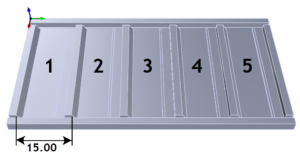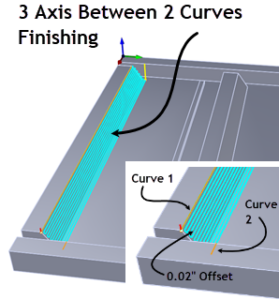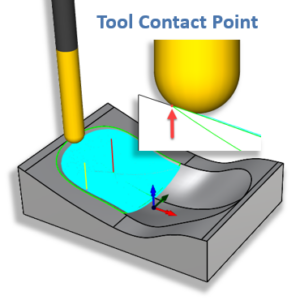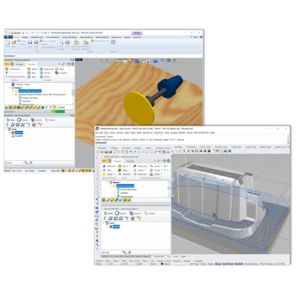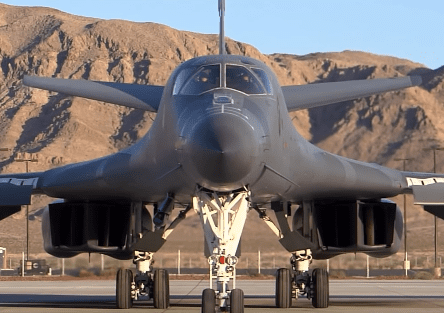 Lance Corporal Zachary Geragi, USMC (medically retired) from Farmington, MN, an Iraq war veteran and his team of RC hobbyists are on a historic mission. To be the first to build and fly an AMA flight certified radio controlled ⅛ scale replica of the B1 Lancer Bomber jet aircraft (the actual B1 is shown here)! Because of the technical difficulty, this feat has yet to be successfully accomplished and no easy feat it is.
The ⅛” scale jet aircraft adheres to AMA weight restrictions and is built with the same space-age technology including honeycomb & carbon fiber composite construction and 820 epoxy resin used on the actual Lockheed Martin F-22 Raptor and F-35 Lightning! All of the CNC machining g-code for this project was generated using VisualCAM from MecSoft Corporation. This case study is our tribute to Zach and his team of RC hobbyists for taking on this historic project.
Lance Corporal Zachary Geragi, USMC (medically retired) from Farmington, MN, an Iraq war veteran and his team of RC hobbyists are on a historic mission. To be the first to build and fly an AMA flight certified radio controlled ⅛ scale replica of the B1 Lancer Bomber jet aircraft (the actual B1 is shown here)! Because of the technical difficulty, this feat has yet to be successfully accomplished and no easy feat it is.
The ⅛” scale jet aircraft adheres to AMA weight restrictions and is built with the same space-age technology including honeycomb & carbon fiber composite construction and 820 epoxy resin used on the actual Lockheed Martin F-22 Raptor and F-35 Lightning! All of the CNC machining g-code for this project was generated using VisualCAM from MecSoft Corporation. This case study is our tribute to Zach and his team of RC hobbyists for taking on this historic project. Why this Mission?

Why VisualCAM for SOLIDWORKS?
 |
The Composite Carbon Fiber Fuselage
 The fuselage core for the RC B1 Lancer was actually 3D scanned from a plastic Revell model kit including the actual panel lines!. The scan was then scaled to ⅛ actual size and converted to a closed surface model. The fuselage 3D model was then cut into sections so that they could be machined from 48”x96”x4” foam sheets on Zach’s routing table. The typical VisualCAM Machining Job is shown here. Each sheet is one SOLIDWORKS assembly of fuselage sections. The fuselage assembly section components are listed in the Parts section of the Machining Job. The setup for each sheet consists of a 3 Axis Horizontal Roughing operation using a ½” end mill and a Horizontal Finishing operation using a ¼” ball mill. Two of the sheets are shown below along with some cool images and videos.
The fuselage core for the RC B1 Lancer was actually 3D scanned from a plastic Revell model kit including the actual panel lines!. The scan was then scaled to ⅛ actual size and converted to a closed surface model. The fuselage 3D model was then cut into sections so that they could be machined from 48”x96”x4” foam sheets on Zach’s routing table. The typical VisualCAM Machining Job is shown here. Each sheet is one SOLIDWORKS assembly of fuselage sections. The fuselage assembly section components are listed in the Parts section of the Machining Job. The setup for each sheet consists of a 3 Axis Horizontal Roughing operation using a ½” end mill and a Horizontal Finishing operation using a ¼” ball mill. Two of the sheets are shown below along with some cool images and videos.

 |
 |
Once the ⅛ scale fuselage sections were machined and assembled, they were used as the core plugs to layup each section of the composite carbon fiber outer shell. The carbon fiber sections were then assembled to form the complete light weight and extremely strong fuselage. Zach is doing an incredible job documenting the complete project on his facebook page so please check them out for many other videos, images and lots of technical discussion. The is a team effort and we want to give a shout out to Zach’s friends and fellow RC hobbyists Richard Steine, Darren Bitzer, and Rick Freeman for joining in on this mission. See below for the team roster and responsibilities.
 |
 |
| Richard Steine (Left) and Darren Bitzer (Right) assist with construction and assembly of the giant 18 foot long B1 Lancer carbon fiber fuselage. | |
|
|
|
| Watch Zach show and discuss the RC B1 Lancer fuselage core mold, carbon fibercomposite components and assembly in the video links above! | |
Other Machined Components
Here are just a few of the additional machined components that comprise the awesome RC B1 Lancer Bomber Project that Zach and his team have completed. This project is not for the faint of heart. I remind you that this IS NOT a pre-designed kit. Zach and his dedicated team will be the first to complete and fly a working ⅛” scale RC B1 Lancer Bomber jet aircraft! They have designed these components in SOLIDWORKS and programmed all of the CAM toolpaths using VisualCAM for SOLIDWORKS!

 |
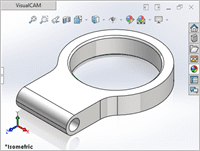 |
 |
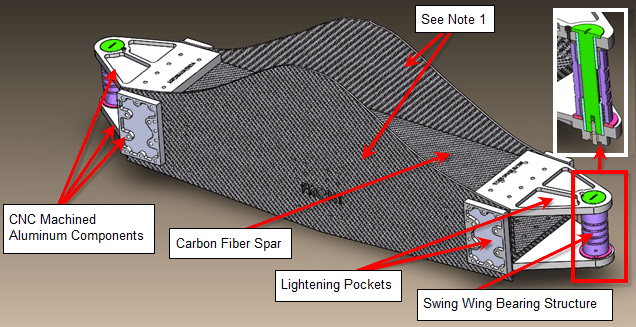
About the Giant RC B1 Lancer Bomber
 Zack’s history making Remote Controlled Swept Wing B1 Lancer Bomber is an AMA approved ⅛” scale gas turbine powered jet aircraft with the following dimensions and specifications:
Zack’s history making Remote Controlled Swept Wing B1 Lancer Bomber is an AMA approved ⅛” scale gas turbine powered jet aircraft with the following dimensions and specifications:
- Expanded Wingspan: 17.0 feet.
- Swept Wingspan: 10.0 feet.
- Total Length: 18.2 feet.
- Total Height: 4.2 feet
- Wing to Ground: 1.0 feet
- Fuselage: Honeycomb & Composite Carbon Fiber
- Engines: Gas Powered Jet Turbines
- Hand-held Radio Controlled
The history of attempting to build an AMA flight-ready RC B1 jet aircraft this large is long, complicated and thus far unsuccessful. However, with the valued input from those previous attempts and with the availability of lightweight and strong composite materials and expertise not available at the time, Zach and his team hopes to be the first!
The Team Roster
Building this 18 foot long history making RC B1 Bomber is a team effort. It requires dedicated RC hobbyists with working knowledge and experience in engineering, design, turbine engine installation & flight testing, composite carbon fiber molding, fabrication, machining, painting, finishing and more. Here is the complete team roster.

To Learn More
To learn about The Minnesota Giant RC B1 Lancer Bomber Project we invite you to read their case study. You can also visit and follow the project’s progress by visiting their Facebook page here.



